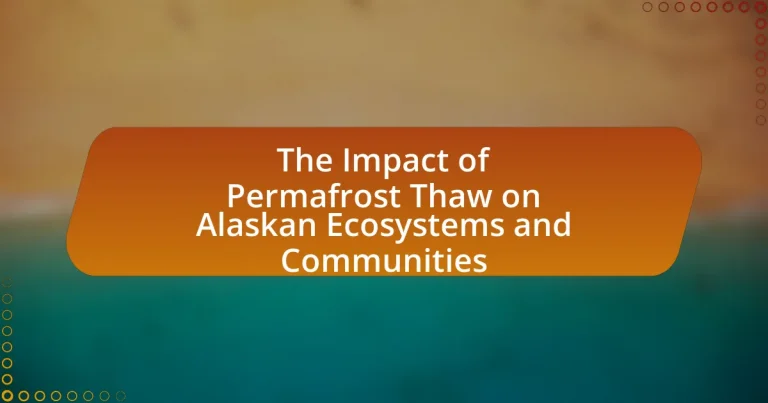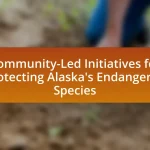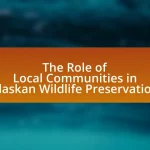Permafrost thaw is a critical issue affecting Alaskan ecosystems and communities, leading to the release of greenhouse gases, alterations in hydrology, and infrastructure destabilization. The thawing process disrupts local wildlife habitats, increases flooding and erosion, and compromises community infrastructure, particularly in vulnerable areas like Shishmaref. Additionally, changes in soil composition and water systems impact plant biodiversity and animal migration patterns, while Indigenous lifestyles face significant challenges due to shifts in traditional food sources. The article explores the ecological consequences of permafrost thaw, community responses, and strategies for adaptation, emphasizing the broader implications for climate change and the importance of proactive measures to enhance resilience.
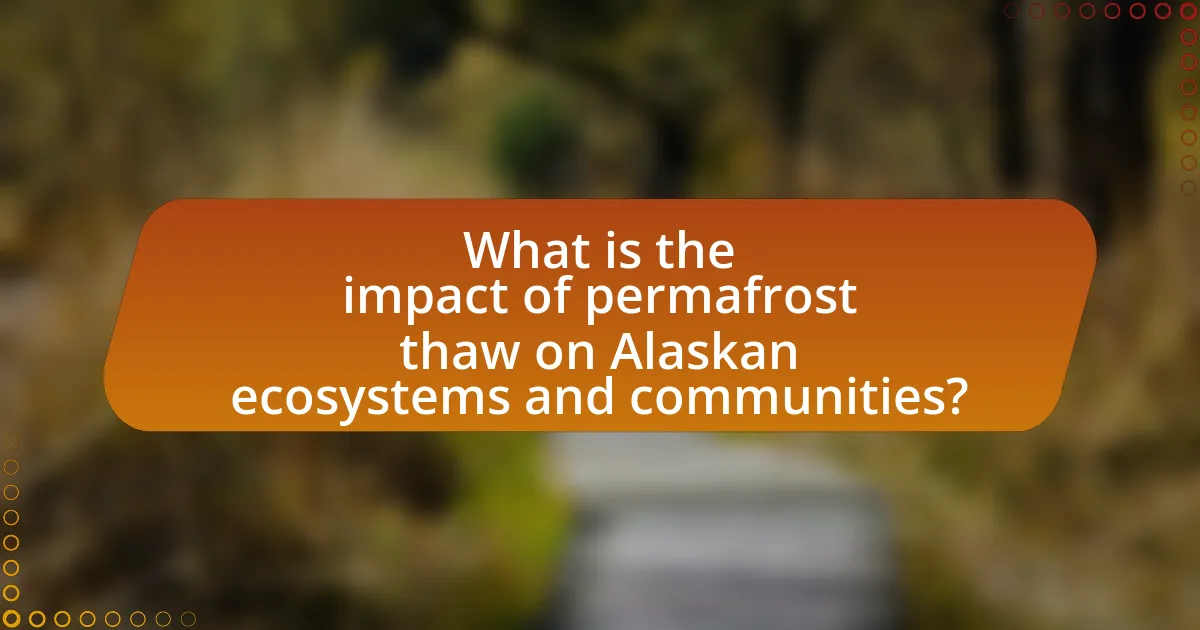
What is the impact of permafrost thaw on Alaskan ecosystems and communities?
Permafrost thaw significantly disrupts Alaskan ecosystems and communities by releasing greenhouse gases, altering hydrology, and destabilizing infrastructure. As permafrost thaws, it releases carbon dioxide and methane, contributing to climate change and affecting local wildlife habitats. Additionally, changes in water flow patterns can lead to increased flooding and erosion, impacting both natural landscapes and human settlements. For instance, the thawing of permafrost has been linked to the deterioration of roads and buildings in communities like Shishmaref, where infrastructure is compromised due to ground instability. These effects underscore the interconnectedness of environmental changes and community resilience in Alaska.
How does permafrost thaw affect the physical environment in Alaska?
Permafrost thaw significantly alters the physical environment in Alaska by destabilizing the ground, leading to increased erosion and changes in hydrology. As permafrost thaws, the previously frozen ground becomes saturated, resulting in the formation of thermokarst, which creates uneven terrain and can collapse infrastructure. Additionally, thawing permafrost releases greenhouse gases like methane and carbon dioxide, contributing to climate change. Studies indicate that approximately 50% of Alaska’s permafrost is projected to thaw by the end of the century, which will further exacerbate these environmental changes.
What changes occur in soil composition due to permafrost thaw?
Permafrost thaw leads to significant changes in soil composition, primarily resulting in increased organic matter decomposition and nutrient release. As permafrost thaws, previously frozen organic materials become accessible to microbial activity, which accelerates decomposition and transforms the soil into a more nutrient-rich environment. This process can increase the availability of nitrogen and phosphorus, essential for plant growth, thereby altering the nutrient dynamics within the ecosystem. Additionally, the thawing process can lead to soil erosion and changes in soil structure, affecting water retention and drainage capabilities. These changes have been documented in various studies, including research published in “Nature Climate Change,” which highlights the implications of thawing permafrost on soil nutrient cycling and ecosystem productivity.
How does thawing permafrost influence water systems in Alaska?
Thawing permafrost significantly alters water systems in Alaska by increasing surface water runoff and altering hydrological patterns. As permafrost thaws, it releases previously trapped water, leading to the formation of new ponds and lakes, which can change local ecosystems and water availability. Additionally, the thawing process can disrupt the natural flow of rivers and streams, causing flooding and erosion. Research indicates that these changes can impact fish habitats and drinking water sources, affecting both wildlife and human communities reliant on these water systems.
What ecological consequences arise from permafrost thaw?
Permafrost thaw leads to significant ecological consequences, including the release of greenhouse gases, disruption of local ecosystems, and changes in hydrology. As permafrost thaws, stored carbon in the form of methane and carbon dioxide is released into the atmosphere, contributing to climate change; studies indicate that thawing permafrost could release up to 1,500 billion tons of carbon, exacerbating global warming. Additionally, the melting of permafrost alters the habitat for various species, affecting biodiversity and food webs. Changes in hydrology occur as thawing alters water flow patterns, leading to increased flooding and changes in water quality, which can impact aquatic ecosystems.
How does permafrost thaw impact plant biodiversity in Alaskan ecosystems?
Permafrost thaw significantly impacts plant biodiversity in Alaskan ecosystems by altering soil composition and moisture levels, which can lead to changes in species distribution and abundance. As permafrost thaws, it releases nutrients and increases soil moisture, creating conditions that favor certain plant species over others. For instance, studies have shown that thawing can promote the growth of shrubs and other vascular plants, potentially outcompeting native herbaceous species. This shift in plant communities can disrupt existing ecosystems and affect the wildlife that relies on specific plant species for food and habitat.
What effects does thawing have on animal habitats and migration patterns?
Thawing significantly alters animal habitats and migration patterns by disrupting ecosystems and changing food availability. As permafrost thaws, it leads to habitat loss for species that rely on stable ground, such as caribou and migratory birds, which depend on specific vegetation and breeding grounds. Additionally, thawing can create new water bodies, altering migration routes and timing, as animals adapt to changing landscapes. Research indicates that species like the Arctic fox and snow geese are experiencing shifts in their migratory patterns due to these environmental changes, which are driven by the warming climate and permafrost degradation.
How do communities in Alaska respond to the challenges posed by permafrost thaw?
Communities in Alaska respond to the challenges posed by permafrost thaw by implementing adaptive strategies such as infrastructure redesign, community planning, and traditional ecological knowledge integration. For instance, many Alaskan communities are retrofitting buildings and roads to withstand shifting ground conditions caused by thawing permafrost, which can lead to structural instability. Additionally, local governments are engaging in comprehensive planning efforts that incorporate climate projections and permafrost mapping to inform future development. Research indicates that integrating traditional ecological knowledge with scientific data enhances resilience, as Indigenous practices often include sustainable land management techniques that have been effective for centuries. These responses are crucial for mitigating the socio-economic impacts of permafrost thaw, which threatens housing, transportation, and local ecosystems.
What adaptations are being made by local communities to cope with environmental changes?
Local communities in Alaska are implementing various adaptations to cope with environmental changes caused by permafrost thaw. These adaptations include the construction of elevated infrastructure to prevent damage from melting permafrost, the use of innovative building materials that can withstand shifting ground conditions, and the development of community-based monitoring systems to track environmental changes. For instance, the city of Shishmaref has begun relocating homes and critical facilities to higher ground to mitigate flooding risks associated with thawing permafrost. Additionally, local governments are engaging in collaborative planning efforts with scientists and indigenous knowledge holders to create sustainable land-use strategies that address the impacts of climate change. These proactive measures are essential for enhancing community resilience in the face of ongoing environmental challenges.
How does permafrost thaw affect traditional lifestyles and practices of Indigenous peoples?
Permafrost thaw significantly disrupts the traditional lifestyles and practices of Indigenous peoples by altering the landscape and affecting subsistence activities. As permafrost thaws, it leads to changes in vegetation, wildlife habitats, and the availability of traditional food sources such as fish and game, which are crucial for the diets and cultural practices of Indigenous communities. For example, the thawing of permafrost can result in increased erosion and flooding, impacting fishing and hunting grounds. Additionally, the melting permafrost can release greenhouse gases, further exacerbating climate change, which poses additional challenges to the sustainability of traditional practices. Studies have shown that these environmental changes threaten the cultural heritage and food security of Indigenous peoples, as they rely heavily on the land for their way of life.
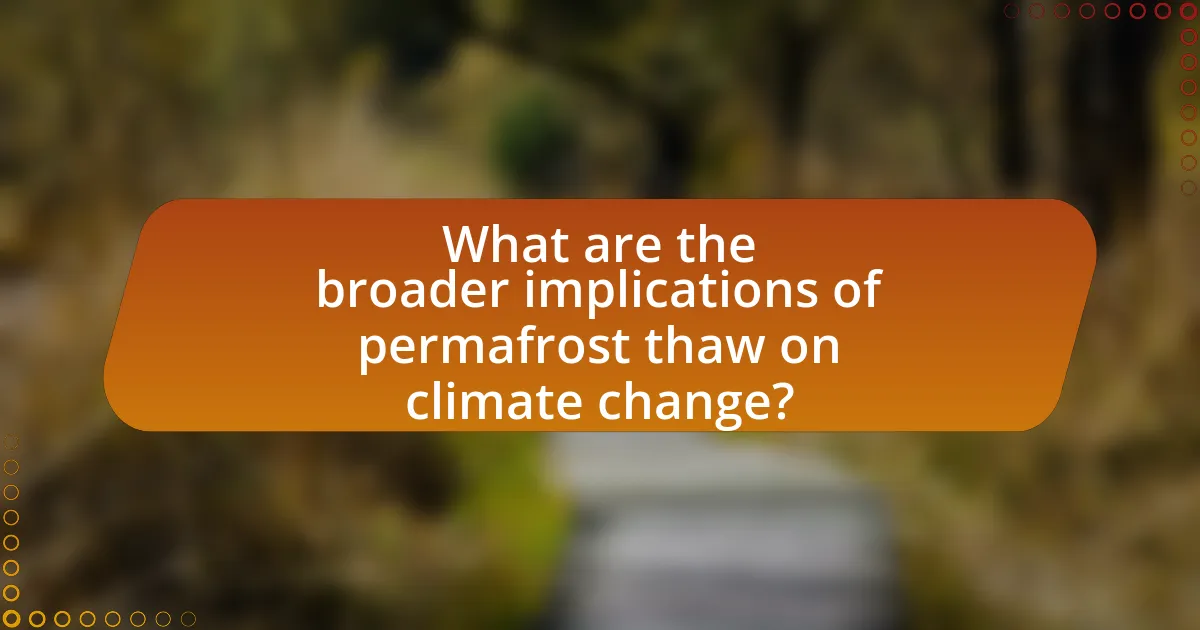
What are the broader implications of permafrost thaw on climate change?
Permafrost thaw significantly accelerates climate change by releasing large amounts of greenhouse gases, particularly carbon dioxide and methane, into the atmosphere. As permafrost thaws, it exposes previously trapped organic matter, which decomposes and emits these gases, contributing to the greenhouse effect. Research indicates that the Arctic region could release an estimated 1,500 billion tons of carbon if permafrost continues to thaw at current rates, further exacerbating global warming. This feedback loop not only increases atmospheric temperatures but also disrupts local ecosystems and communities, leading to changes in vegetation, wildlife habitats, and increased risks of natural disasters.
How does permafrost thaw contribute to greenhouse gas emissions?
Permafrost thaw contributes to greenhouse gas emissions primarily by releasing stored carbon dioxide and methane into the atmosphere. As permafrost thaws due to rising temperatures, organic matter that has been frozen for centuries begins to decompose, a process that generates these potent greenhouse gases. Research indicates that permafrost contains approximately 1,500 billion tons of carbon, and its thawing could release significant amounts of carbon dioxide and methane, exacerbating climate change. For instance, a study published in the journal Nature in 2019 highlighted that thawing permafrost could release up to 1.5 billion tons of carbon annually by 2100, further intensifying global warming.
What specific gases are released during permafrost thawing?
During permafrost thawing, specific gases released include carbon dioxide (CO2) and methane (CH4). These gases are produced as organic matter decomposes in the anaerobic conditions of thawed permafrost. Research indicates that permafrost contains approximately 1,500 billion tons of carbon, and as it thaws, the release of CO2 and CH4 contributes significantly to greenhouse gas emissions, exacerbating climate change.
How do these emissions impact global climate patterns?
Emissions from permafrost thaw significantly impact global climate patterns by releasing large quantities of greenhouse gases, primarily carbon dioxide and methane. These gases contribute to the greenhouse effect, which leads to increased global temperatures. Research indicates that permafrost contains approximately 1,500 billion metric tons of carbon, and as it thaws, this carbon is released into the atmosphere, exacerbating climate change. The Intergovernmental Panel on Climate Change (IPCC) reports that the release of methane is particularly concerning due to its potency as a greenhouse gas, being over 25 times more effective than carbon dioxide over a 100-year period. This feedback loop of warming and further thawing creates a cycle that accelerates climate change, affecting weather patterns, sea levels, and ecosystems worldwide.
What role does permafrost play in the global carbon cycle?
Permafrost acts as a significant carbon reservoir in the global carbon cycle, storing approximately 1,500 billion metric tons of organic carbon. When permafrost thaws due to rising temperatures, this stored carbon is released into the atmosphere as carbon dioxide and methane, potent greenhouse gases that contribute to climate change. Studies indicate that the thawing of permafrost could potentially release up to 40 billion metric tons of carbon annually, exacerbating global warming and altering climate patterns. This process highlights the critical role of permafrost in regulating atmospheric carbon levels and underscores its importance in the context of climate change.
How does the thawing of permafrost alter carbon storage in the Arctic?
The thawing of permafrost significantly reduces carbon storage in the Arctic by releasing previously trapped greenhouse gases, primarily carbon dioxide and methane, into the atmosphere. As permafrost thaws, organic matter that has been frozen for centuries begins to decompose, leading to the emission of these gases. Research indicates that the Arctic permafrost contains approximately 1,500 billion metric tons of carbon, and its thawing could release substantial amounts of this carbon, exacerbating climate change. For instance, a study published in the journal “Nature” by Schuur et al. (2015) estimates that the thawing of permafrost could release between 100 to 1,000 billion additional tons of carbon by the year 2100, significantly impacting global carbon cycles and climate systems.
What are the long-term consequences for climate stability?
The long-term consequences for climate stability include increased greenhouse gas emissions, altered weather patterns, and loss of biodiversity. As permafrost thaws, it releases significant amounts of carbon dioxide and methane, potent greenhouse gases that contribute to global warming. Research indicates that the Arctic region is warming at more than twice the global average, leading to more extreme weather events and shifts in ecosystems. For instance, a study published in the journal “Nature” by Schuur et al. (2015) highlights that thawing permafrost could release up to 1,500 gigatons of carbon, exacerbating climate change and destabilizing climate systems. These changes threaten not only the environment but also the livelihoods of communities dependent on stable ecosystems.
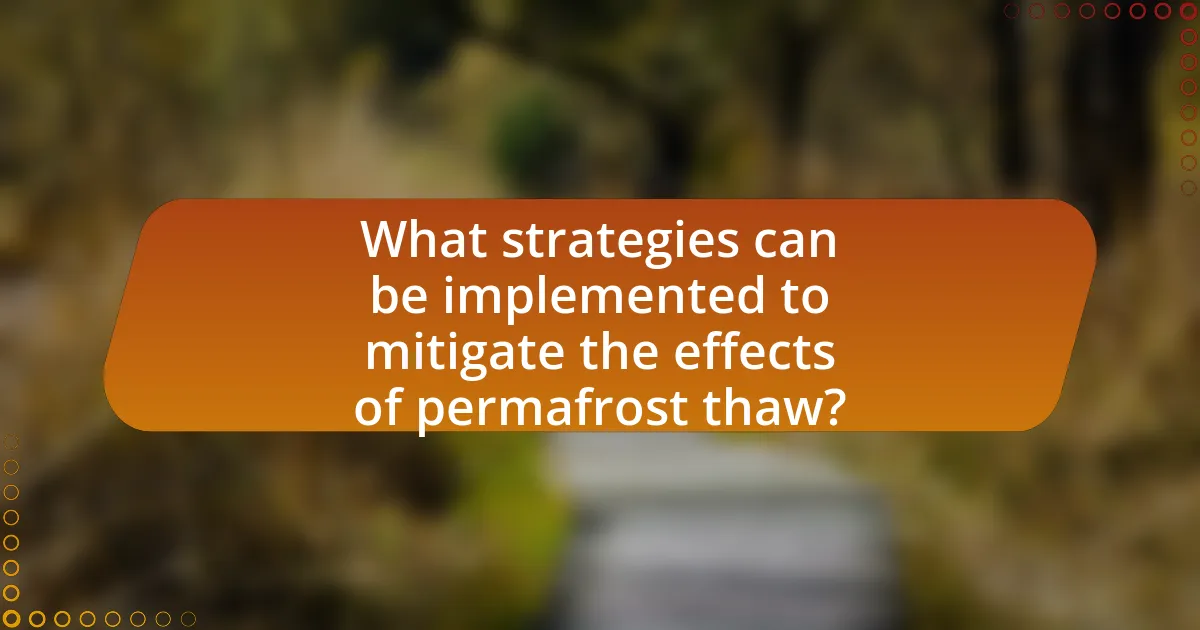
What strategies can be implemented to mitigate the effects of permafrost thaw?
To mitigate the effects of permafrost thaw, strategies such as enhancing vegetation cover, implementing engineering solutions, and adopting land-use planning can be employed. Enhancing vegetation cover helps stabilize the soil and reduce heat absorption, which can slow down thawing. Engineering solutions, such as building structures on pilings or using thermosyphons, can help maintain ground temperatures and prevent thawing. Additionally, land-use planning that incorporates climate resilience can minimize the impact of thawing on infrastructure and ecosystems. These strategies are supported by research indicating that proactive measures can significantly reduce the adverse effects of permafrost thaw on both ecosystems and communities in Alaska.
What are the best practices for managing ecosystems affected by permafrost thaw?
The best practices for managing ecosystems affected by permafrost thaw include implementing adaptive management strategies, restoring natural hydrology, and monitoring ecosystem changes. Adaptive management allows for flexible responses to ongoing changes, ensuring that management practices can be adjusted based on observed outcomes. Restoring natural hydrology helps maintain the ecological balance by reestablishing water flow patterns disrupted by thawing permafrost. Monitoring ecosystem changes through regular assessments provides critical data to inform management decisions and track the effectiveness of interventions. These practices are supported by research indicating that proactive management can mitigate the negative impacts of permafrost thaw on biodiversity and ecosystem services.
How can restoration efforts support biodiversity in thawed areas?
Restoration efforts can support biodiversity in thawed areas by reestablishing native plant species and improving habitat conditions. These efforts can mitigate the effects of climate change by enhancing soil stability and water retention, which are crucial for sustaining diverse ecosystems. For instance, planting native vegetation can help restore the natural balance of the ecosystem, providing food and shelter for various wildlife species. Research indicates that areas where restoration has occurred show increased species richness and abundance, demonstrating the effectiveness of these initiatives in promoting biodiversity.
What role do conservation policies play in addressing permafrost thaw impacts?
Conservation policies play a crucial role in mitigating the impacts of permafrost thaw by promoting sustainable land use and protecting vulnerable ecosystems. These policies help to regulate development activities that could exacerbate thawing, such as oil extraction and infrastructure expansion, thereby reducing greenhouse gas emissions released from thawing permafrost. For instance, the implementation of the Arctic Conservation Act has led to the establishment of protected areas that preserve critical habitats and maintain ecosystem integrity, which is essential for resilience against climate change. Additionally, conservation policies facilitate research and monitoring efforts, enabling better understanding and management of permafrost dynamics and their effects on local communities and wildlife.
How can communities adapt to the socio-economic challenges posed by permafrost thaw?
Communities can adapt to the socio-economic challenges posed by permafrost thaw by implementing infrastructure improvements, diversifying local economies, and enhancing community engagement in climate resilience planning. Infrastructure improvements, such as building elevated structures and using flexible materials, can mitigate damage from thawing ground. Diversifying local economies by investing in sustainable industries, like renewable energy and eco-tourism, can reduce reliance on traditional sectors vulnerable to climate change. Additionally, engaging community members in climate adaptation strategies fosters local knowledge and ensures that solutions are culturally relevant and effective. These approaches are supported by research indicating that proactive adaptation measures can significantly reduce the socio-economic impacts of permafrost thaw on communities.
What resources are available for communities to enhance resilience against climate impacts?
Communities can enhance resilience against climate impacts through various resources, including federal and state funding programs, technical assistance, and community-based adaptation initiatives. For instance, the Federal Emergency Management Agency (FEMA) provides grants for hazard mitigation projects that help communities prepare for climate-related disasters. Additionally, the National Oceanic and Atmospheric Administration (NOAA) offers tools and resources for climate adaptation planning, such as the Climate Resilience Toolkit, which assists communities in assessing vulnerabilities and developing strategies. Furthermore, local organizations often engage in capacity-building efforts, providing training and resources to empower communities in implementing sustainable practices. These resources collectively support communities in addressing the challenges posed by climate change, particularly in regions affected by permafrost thaw, which can lead to significant ecological and infrastructural impacts.
How can education and awareness programs support community adaptation efforts?
Education and awareness programs can significantly enhance community adaptation efforts by providing essential knowledge about the impacts of permafrost thaw on local ecosystems and livelihoods. These programs equip community members with information on climate change, its effects on permafrost, and strategies for adaptation, fostering resilience. For instance, research indicates that communities engaged in educational initiatives are better prepared to implement adaptive measures, such as altering land use practices and improving infrastructure to withstand thaw-related challenges. Furthermore, awareness campaigns can facilitate collaboration among stakeholders, ensuring that local voices are included in decision-making processes, which is crucial for effective adaptation strategies.
